Homemade Eggnog
This post may contain affiliate links. Read our disclosure policy.
Why buy eggnog when you can make our homemade eggnog recipe in under 5 minutes? This easy Amish recipe is versatile. Sweeten and season to your liking. And there’s a cooked eggnog option, too!
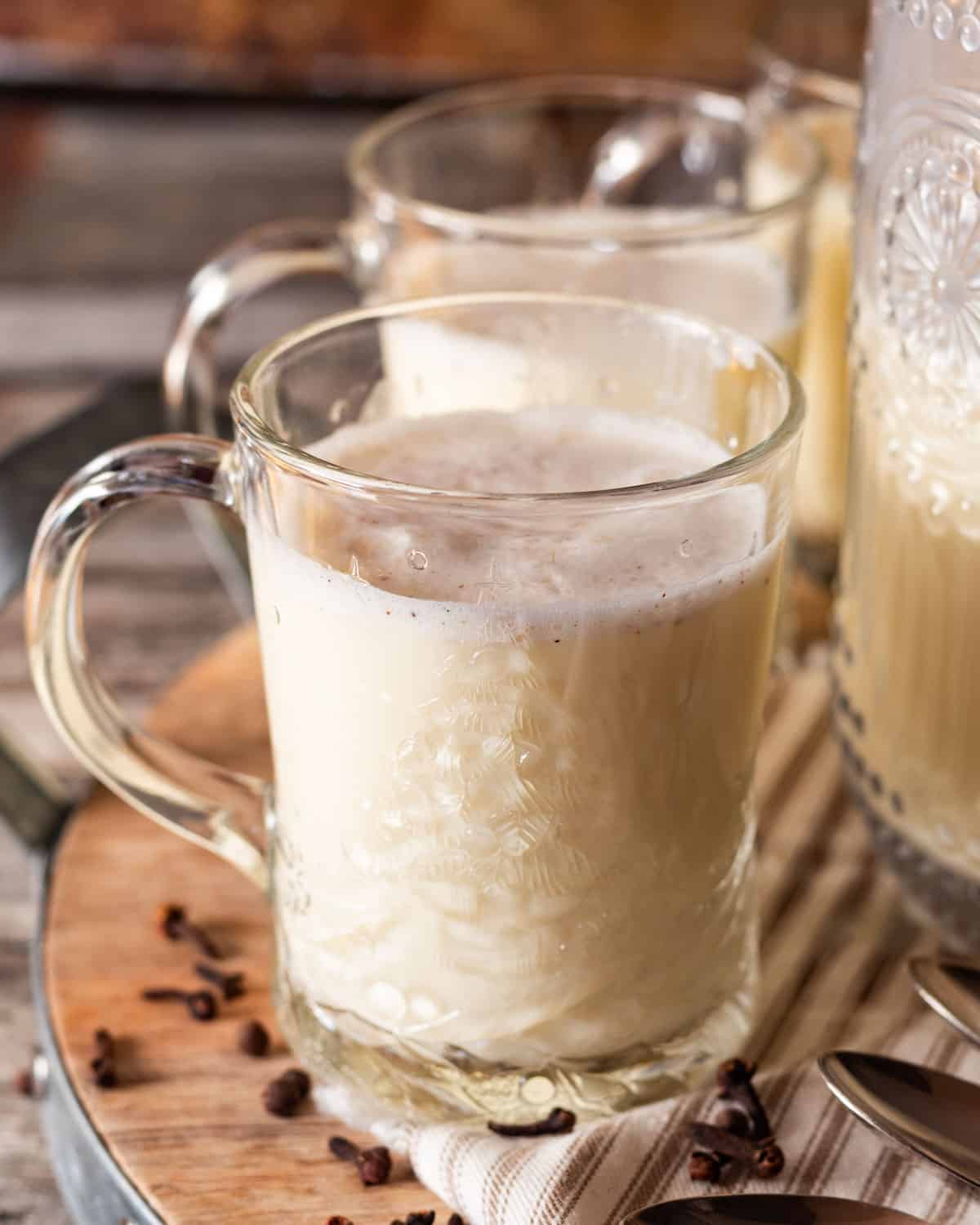
Homemade eggnog is one of Matt’s favorite holiday traditions, yet in our early years of marriage I rarely made it for him because, well….it wasn’t one of my holiday traditions. He grew up enjoying glasses of eggnog alongside snickerdoodle cookies and this was a memory I wanted to bring back for him.
I flipped open my tattered, well-loved Amish cookbook, looked up how to make eggnog and found an old traditional eggnog recipe. 7 eggnog ingredients that I already had in my refrigerator and pantry? No problem.
I whipped it up in under 5 minutes, poured a glass for Matt {the official taste tester}. He thought the homemade eggnog was amazingly delicious and fell in love with me all over again with just one taste. There’s no going back to store-bought eggnog for him.
How safe is homemade eggnog?
My first question to answer with this old recipe is the current guidelines for making eggnog with raw eggs.
After a quick look at FoodSafety.gov, I learned the following two options for safe homemade eggnog.
- Make the homemade eggnog recipe with pasteurized eggs. This heating process kills any salmonella or other bacteria that might be present, which lowers the risk. Some age groups (over 65 and under 5), pregnant women and those with weakened immune systems should still be careful with this option.
- Make a cooked eggnog recipe. The homemade eggnog is totally safe for all to drink when it is cooked.
Make the easy eggnog recipe with unpasteurized raw eggs is NOT recommended by FoodSafety.gov because of the risk of salmonella. That risk is relatively small, but is still there.
I know that there will be some of you who say “Heck with it…I’m making it with raw eggs.” And I know there are some of you who will shout from the rooftops that you should NOT be drinking homemade eggnog that has not been cooked.
So I’ll share with you a quick 5-minute version that you can make using raw, pasteurized eggs….and then I’ll tell you how to make cooked homemade eggnog for the ultimate in food safety. Either way, this is the best eggnog recipe!
An Easy Eggnog Recipe
- Crack the pasteurized eggs into a bowl and whip them with a hand mixer until they are frothy on top and lemon in color, about 1-2 minutes.
- Add the sugar, nutmeg, lemon juice, salt, milk and cream. Beat it again for another 1-2 minutes until the eggnog is frothy.
- Beat with a hand mixer for 1-2 minutes or until the eggnog is frothy.
- Chill in the fridge until serving. Pour yourself a tall glass of this cold eggnog, sprinkle the top with nutmeg or garnish with your other favorite holiday spices and enjoy every sip.
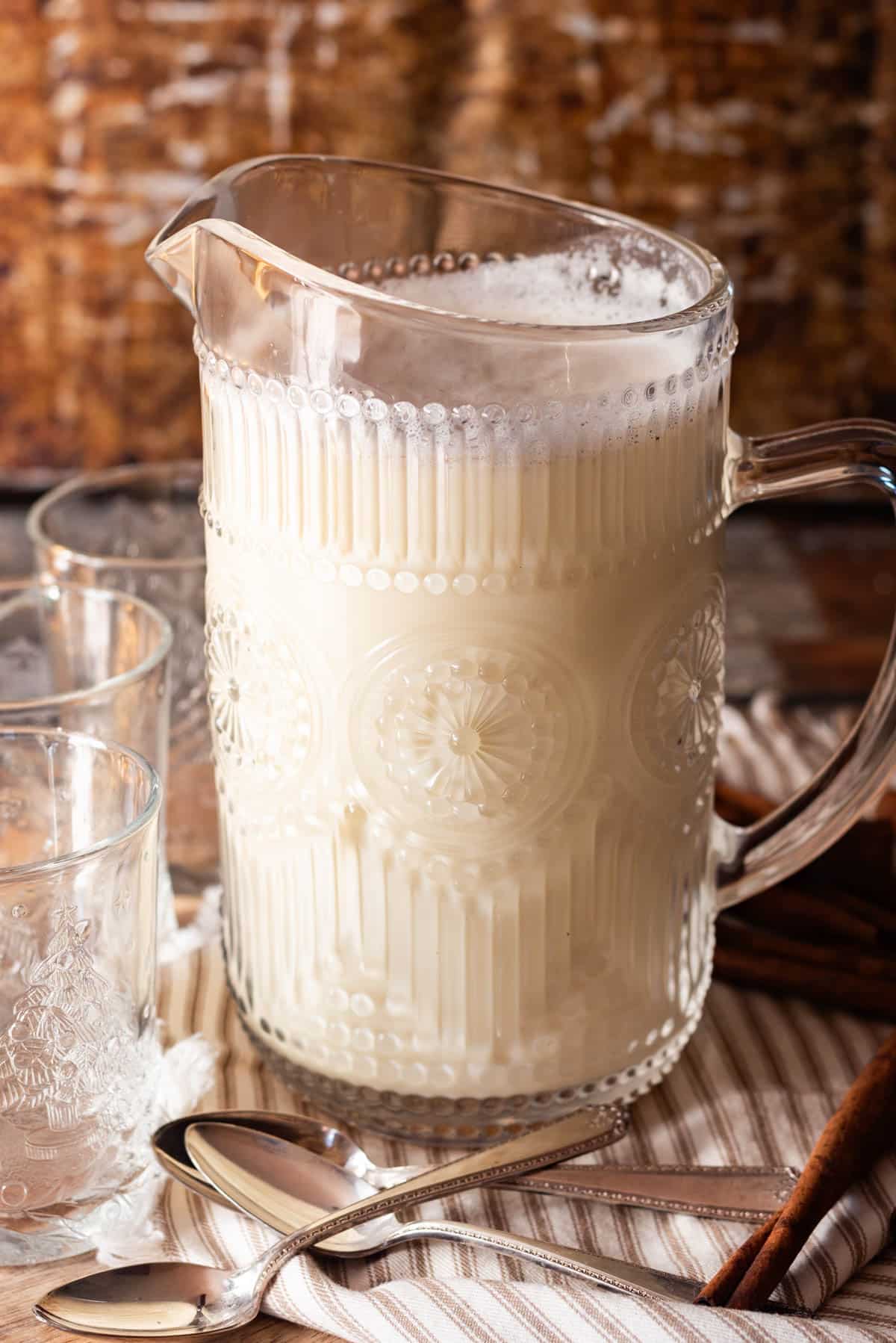
A Cooked Eggnog Recipe
This recipe takes just a little more time but has only 6 ingredients. Do not add the lemon juice to the cooked eggnog. Trust me. It will curdle. Don’t ask me how I know.
- Heat the milk and cream in a saucepan over medium heat until it is about 115-120ºF.
- In another bowl, use a hand mixer to blend together the eggs for 1-2 minutes or until they are lemon in color.
- Scoop ¾ cup of the heated milk and pour it slowly into the eggs, whisking constantly. This is called “tempering” the eggs.
- Now slowly pour the egg mixture slowly into the hot milk mixture, whisking constantly. Stir in the sugar, nutmeg and salt. Heat over medium-low heat, whisking constantly, until the temperature reaches 165º F. This is a safe temperature for the eggs.
- The last step is chilling the eggnog in a pitcher in the fridge. The cooked version will thicken as it cools, so I recommend drinking the eggnog sooner rather than later. If the cooked eggnog thickens too much, you can add milk (plus a bit more sugar and nutmeg) to get it to the consistency you like.
And that my friends….is all I have learned about eggnog in the past few weeks. It was more of a lesson than I thought I would learn.
But the recipe itself? Matt said it reminds him of his Grandma and that is a priceless reaction for me.
Be sure to read all of the notes to make this eggnog exactly how you like it!
If you love eggnog, try Eggnog Cream Cake!
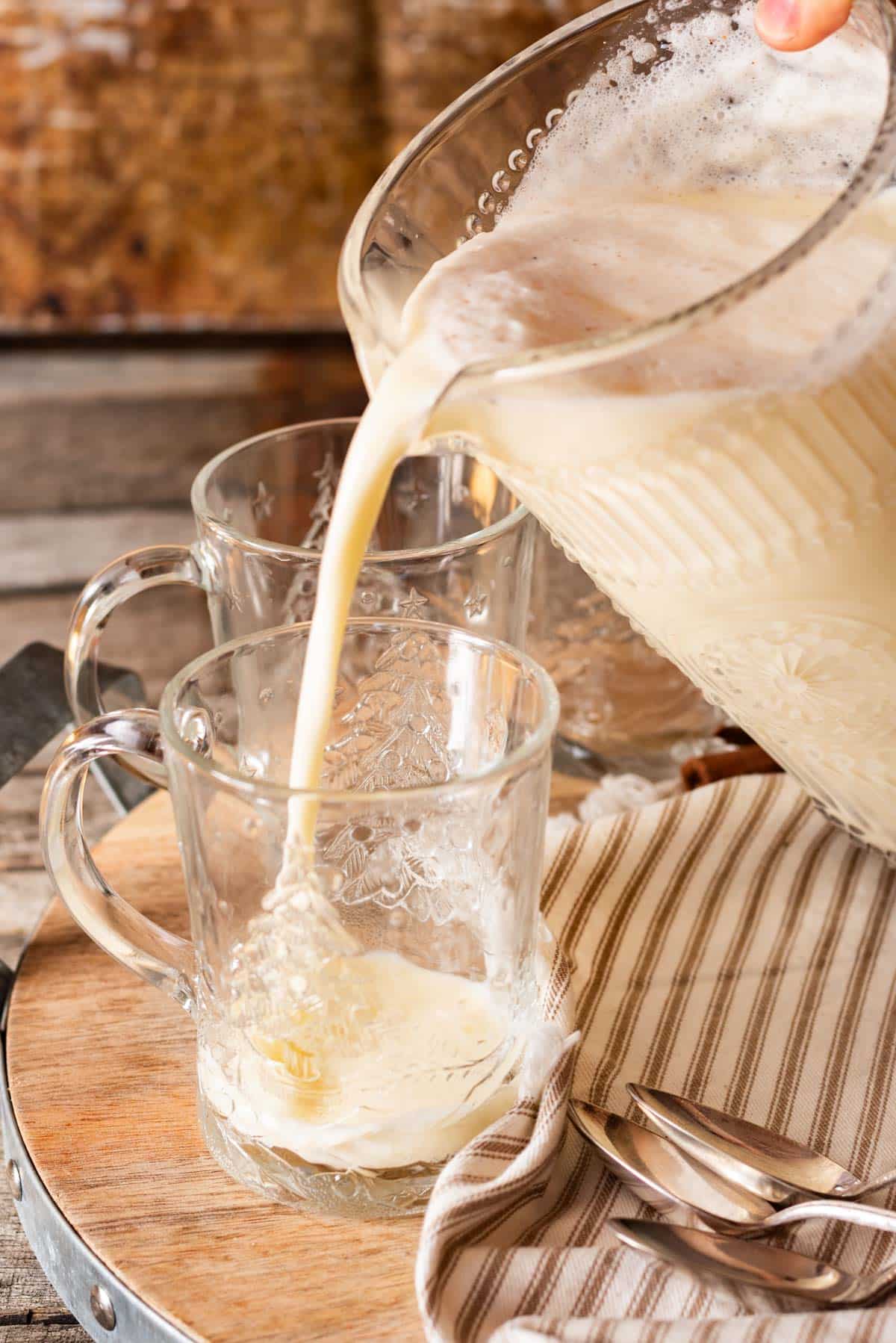
Recipe Variations
- People often add alcohol to homemade eggnog. Alcohol such as bourbon, whiskey, rum or brandy have flavors that pair well with the creamy eggnog.
- Add vanilla extract. It will almost taste like melted ice cream!
- Kids love this with homemade whipped cream on top. Take 1 cup of heavy cream and whip it with ¼ cup powdered sugar and 1 teaspoon of vanilla extract. Whip until soft peaks form, then top the egg nog with the whipped cream once it is in glasses.
- Use any variation of whole milk or cream that you’d like.
Can you bake with eggnog?
Yes! Homemade eggnog might have a little bit of a different thickness than store bought milk or store bought eggnog, so a recipe might need a little tweaking. But in general, you can often replace milk with eggnog in baked goods. We’ve also found you can reduce the sugar slightly since eggnog is already sweetened.
Try one of these:
Storage Instructions
Store leftover homemade eggnog in the fridge for up to 3 days.


Homemade Eggnog
Why buy eggnog when you can make homemade eggnog in under 5 minutes? This easy Amish recipe is versatile. Sweeten and season to your liking.
Servings 6 servings
Prep Time 5 minutes
Total Time 5 minutes
Ingredients
- 4 large pasteurized eggs
- 1/3 cup granulated sugar
- 1/8 teaspoon ground nutmeg
- 2 tablespoons lemon juice
- 1/8 teaspoon salt
- 4 cups 2% milk
- 1/2 cup heavy cream
Instructions
Pasteurized Egg Easy Eggnog:
- In a large bowl, beat the eggs until they are thick and lemon colored. 4 large pasteurized eggs
- Whisk in the sugar, nutmeg, lemon juice and salt. Add the milk and cream. ⅓ cup granulated sugar, ⅛ teaspoon ground nutmeg, 2 tablespoons lemon juice, ⅛ teaspoon salt, 4 cups 2% milk, ½ cup heavy cream
- Beat with a hand mixer for 1-2 minutes or until the eggnog is frothy.
- Serve with ice. Makes 6 large glasses.
Cooked Eggnog (Do not add the lemon juice):
- Heat the milk and cream in a saucepan over medium heat until it is about 115-120ºF.
- In another bowl, use a hand mixer to blend together the eggs for 1-2 minutes or until they are lemon in color.
- Scoop ¾ cup of the heated milk and pour it slowly into the eggs, whisking constantly. This is called "tempering" the eggs.
- Now slowly pour the egg mixture slowly into the heated milk, whisking constantly. Stir in the sugar, nutmeg and salt. Heat over medium-low heat, whisking constantly, until the temperature reaches 165º F. This is a safe temperature for the eggs.
- The last step is chilling the eggnog in a pitcher in the fridge. The cooked version will thicken as it cools, so I recommend drinking the eggnog sooner rather than later. If the cooked eggnog thickens too much, you can add milk (plus a bit more sugar and nutmeg) to get it to the consistency you like.
Video
Notes
- Adjust the sugar to your liking. Add more or less.
- You can also add a bit more nutmeg or even cinnamon if you’d like.
- Want your eggnog creamier? Use more cream and less milk.
- If you make the cooked version and you end up with little pieces of egg, pour the eggnog through a fine mesh strainer to make it smooth again.
- Refer to the article above for more tips and tricks. The calories shown are based on the recipe serving 6, with 1 serving being 1 glass of eggnog. Since different brands of ingredients have different nutritional information, the calories shown are just an estimate. **We are not dietitians and recommend you seek a nutritionist for exact nutritional information. **
Nutrition
Calories: 238kcal | Carbohydrates: 20g | Protein: 10g | Fat: 14g | Saturated Fat: 8g | Polyunsaturated Fat: 1g | Monounsaturated Fat: 4g | Trans Fat: 0.1g | Cholesterol: 159mg | Sodium: 175mg | Potassium: 291mg | Fiber: 0.02g | Sugar: 20g | Vitamin A: 632IU | Vitamin C: 2mg | Calcium: 221mg | Iron: 1mg

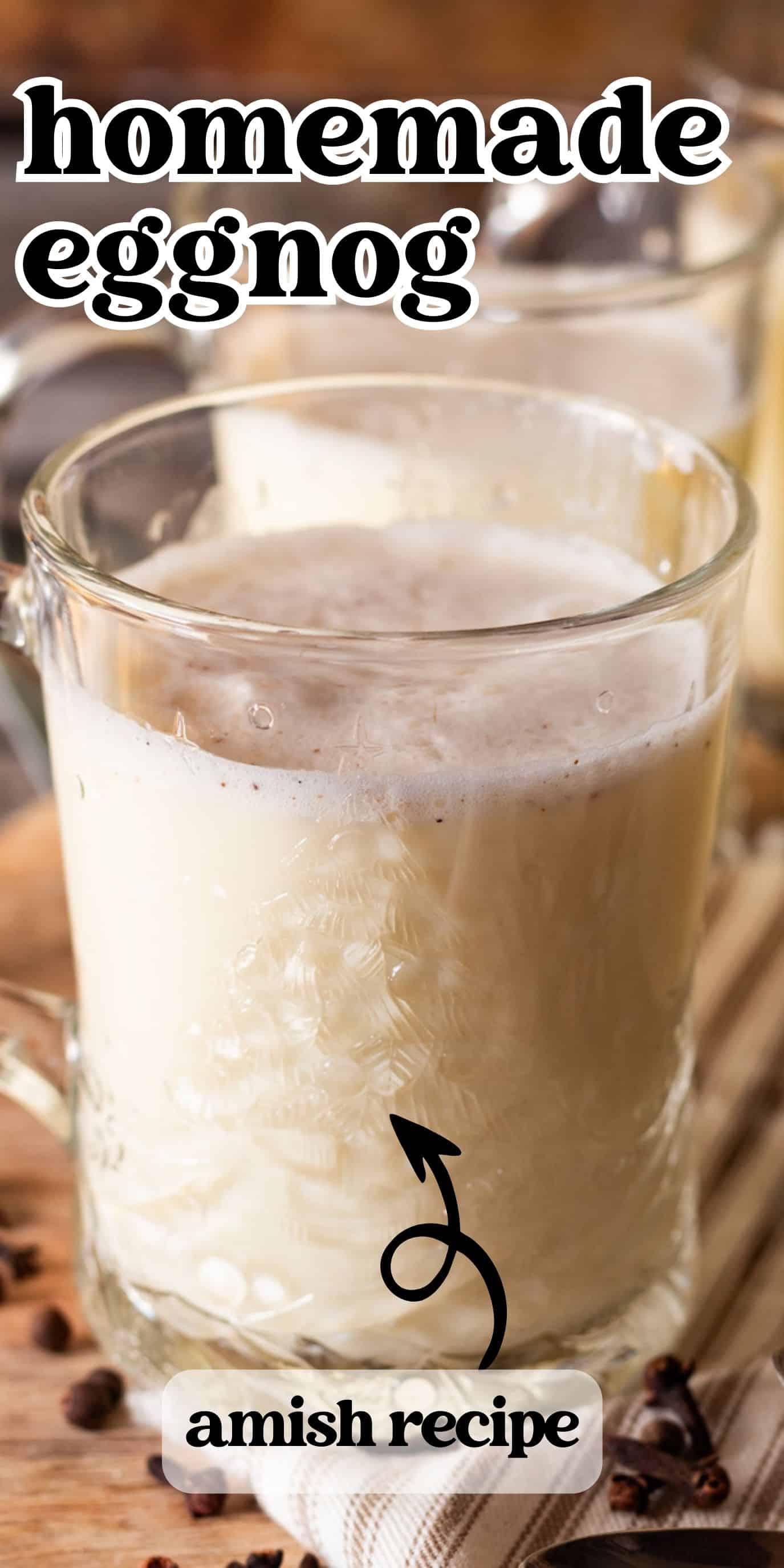

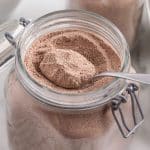

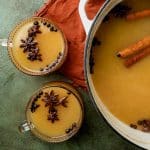
The cooked version works well with whole milk and no cream, and I reduced the eggs to three – saves a little money and still tastes rich and creamy.
Ive made my egg nog for years without cooking it! If you add acid to the egg yolks — either in the form of lemon juice or vinegar. Adding acid raises the temperature at which egg yolks cook, which heats them to 140°F, killing the bacteria, but without cooking the egg. Amazing recipe, so easy and 100% better than store bought:)
I just made this for the first time. (I made the cooked version because it’s for a party.) It was SO easy! And it is smooth and tastes great! Thanks for sharing!!!
I’m sorry, but this needs some flavor. It’s really just sweet milk with the ratio of 1 egg per cup of milk. Some spice would be good too, maybe vanilla, cinnamon, even some more sugar. I made the tempered version btw.
This recipe is almost like the one I used to make myself in the 70’s. It was not fancy crazy in those days. Egg, milk, sugar and I am still wondering if I added vanilla…no cooking just stir and drink!
Making this now with non-factory uncooked and unpasteurized eggs. ( real free range eggs from friend ). Expect it will be great ! Will not be using 10.25 kg of milk as per the metric list of ingredients though. At 8.6 lbs. per US gallon that would be about 2 1/2 Gallons.
Made this New Years Day – It was delicious. Made the raw egg version, used whole milk and heavy cream. I reduced the sugar to 1/4 c and increased the nutmeg. Next time I will try pure maple syrup instead of sugar and add a teaspoon of vanilla.
Thanks so much!!! This was a quick recipe, too. Serving in less than 15 min.
Thanks for not being a wuss
I did the raw egg and it was fantastic
I made it twice. And I made a few minor adjustments the second time that made it wonderful. I used Conagra liquid egg product with whole eggs (because it was the only pasteurized eggs I could find). I don’t know if it would have been better with fresh eggs, but it was wonderful even with the egg product. Anyway, here were the adjustments the second time: Increased the amount of egg ever so slightly Increased the sugar to just over 1/2 cup. Increase the nutmeg a little (I didn’t measure it). Decreased the lemon juice ever so slightly. (maybe by… Read more »
I made the cooked version. Very good. I used whole milk and half/ half (because that’s what I had) Thanks for sharing your recipe.
Delicious eggnog! Made the cooked egg version. Love that it is so easy to make and ready so soon.
Family loves it. Bravo and thank you!
This is my new favorite eggnog recipe! It is creamy – just the right amount of sweetness – easy and without waste. Thanks for sharing this! My family loves it and we will probably keep a little in the frig year round.
It was amazing
‘without the ice’
Great recipe. I been wanting to make eggnog for years now. Turned out great. Fast and easy. I used fresh eggs from a local ranch and added twice the cream and doubled the nut meg. Looking forward in making this again.
I just made this recipe, and the flavor is good, but it’s not thick at all. Should I add another egg, or does this thicken when it’s refrigerated?
Thanks, and Happy Thanksgiving!